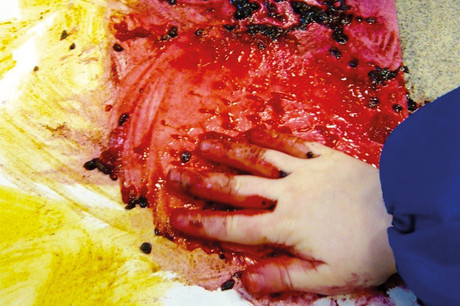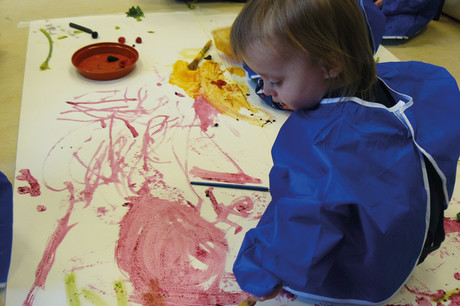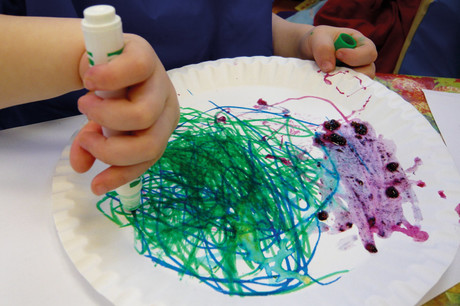
A visiting artist has been working with First Steps Nursery in Salisbury to get children as young as three months old exploring their own creativity by experimenting with unusual objects and materials.
As an artist and creative learning consultant, James Aldridge has worked with various organisations around the world, including independent arts-based action research organisation 5x5x5=creativity.
‘Originally, I did a sculpture degree so I’m very much interested in materials and the relationship between materials and the body and how that relates to learning,’ he explains. ‘I’ve always had a twin fascination for the environment and natural history, so I ended up going down the route of using art as a tool for enabling people to engage with their environment.’
Of his various art projects with under-fives, three have been with First Steps. The most recent, planned to run in conjunction with drawing festival The Big Draw, involved mark-making with edible objects.
‘The nursery was quite open to what direction I took it in but they wanted it to be about making mark-making accessible, about drawing parents in and enabling them to support their children,’ says Mr Aldridge.
‘So we had a home and garden theme and we looked at making use of things that you might find around the home. We used things like coffee and turmeric, food dyes and beetroot, spinach and berries to make marks.
‘I was conscious of the younger children putting things in their mouths so obviously I was looking at what’s safe, but at that multi-sensory side of things as well. So if they ate it that was fine, but if they rubbed it on their leg or rubbed it on the floor they also made a mark.’
POSITIVE RELATIONSHIPS
First Steps’ deputy manager Leigh Chalmers says the project started with a staff and parents’ evening when Mr Aldridge invited everyone to have a go at the activities that he planned to do with the children.
‘This worked in a number of ways,’ Ms Chalmers explains. ‘It’s lovely for the staff to have a heads-up and a bit of training with James, and it’s fantastic for the parents to come in and meet him.
‘Also, it’s for parents to know that their child is not going to come home with a finished piece of work. What the children are going to come home with is an experience and a bit of learning that belongs to them because they’ve made that discovery.
‘So, James brought in strawberries, raspberries, beetroot, charcoal and all sorts of strange and wonderful things and he set up a long dinner table with paper plates and cups and a big white roll of paper. He just said, “Right, go for it!” and we spent two hours one Tuesday evening doing this.’
ACCESSIBLE TO ALL
Part of Mr Aldridge’s brief was to ensure all children could be actively involved in the project. ‘He set it up in two ways,’ Ms Chalmers explains. ‘He had massive pieces of paper on the floor so the children could get down and be physically involved in what they were doing, and he set tables up to look like we were going to have a tea party because a lot of the stuff he was bringing in was edible.’
Babies sat on the large pieces of paper and used the materials provided to make marks both on the paper and themselves. ‘We’ve got a gorgeous picture with a lovely pair of baby feet; that child had sat there with spinach leaves and raspberries and was mark-making and then eating the raspberries,’ continues Ms Chalmers.
‘That’s all fine. The way James works, there’s no right or wrong way and there doesn’t have to be an end product and that’s very much how we want it. We don’t want an end product, we just want an experience.’
Older children had the choice over whether to sit on the floor or at the table. ‘The piece on the floor is good because that becomes like a team piece,’ Ms Chalmers explains. ‘A child can find a spot where they’re working away but somebody’s working next to them on the same big piece of paper.
‘The things on the table were more for the individual. And that gives them the choice about whether to work as a team or just sit quietly and explore by themselves.’
LEARNING OPPORTUNITIES
Ms Chalmers says she has been surprised at the cross-curricular learning opportunities such projects provide. She refers back to 2013 when Mr Aldridge spent six weeks with the nursery leading a project that involved the exploration of sensory materials in the outdoor environment. This included the use of fresh herbs to scent play dough for younger children and the provision of compost, sawdust, clay, stones and sticks for older children.
‘When we first did it, we thought it was going to be an art project but an art project is probably the third or fourth thing down the list of what it is. It’s a social project,’ says Ms Chalmers. ‘There were a couple of children with special educational needs and it allowed them to express themselves in a way that previously they hadn’t been able to. That was absolutely fascinating. Then there is problem-solving; just exploring if you have a rock and you rub the back of the rock with black charcoal, you can print with that on a piece of paper, and then if you put the rock underneath the paper and rub on top of it you can make a rubbing. That kind of exploratory play.
‘Our observations link into all different areas of the EYFS. The children were building things with the rocks, making beautiful sculptures. And then there’s the social side of it, often lots of teamwork and the boys building things together. This isn’t just marks on paper.
‘It’s also fantastic for children who want to just work in an intense, concentrated way. I’ve got a gorgeous observation of a little girl and she must have been on her own for about 45 minutes oblivious to everything else that was going on around her. She created the most amazing piece by rubbing the back of a stone with some charcoal and printing and then seeing what would happen if she added more and more.’
Ms Chalmers says the projects have changed the way she and her staff think about the resources and materials they routinely provide for the children. ‘It’s a big step to take as a practitioner. Saying, “I’m going to let the children paint with raspberries” is a bit weird. But when you’ve done it and when you see that it works, you’re braver. I think it gives the staff a little bit of freedom to feel that they can make choices that are maybe thinking outside of the box. And that really is a big part of our ethos as a nursery. We want our staff to have ownership and be thinking in a creative way.’
CHILD-LED EXPERIENCES
Mr Aldridge and nursery staff observe the children, watching for their interests and fascinations with the aim of providing further resources to extend their explorations.
‘It’s very much focused on observation and documenting so we can see what’s going on and the child’s voice really comes through,’ Mr Aldridge says. ‘Then we can respond to that and plan based on what we’ve seen.’
‘James is very good at observing, noting what the children are playing with and then bringing in more enhancements as and when he needs to,’ adds Ms Chalmers. ‘I think that’s why we work so successfully with him.
‘So, for example, for the mark-making project, he brought in little beans because if you crush a bean you can mark with the stuff that comes out. But actually what a lot of the children wanted to do was plant the beans. So we just went with that and we got soil and they planted the beans and they decorated the pots. It’s really us sitting back and following their lead and seeing where they want to go.’
‘At the end of the day, it’s about putting the child at the centre and responding to them and providing them with a rich toolbox which they can draw from,’ says Mr Aldridge. ‘It’s not about having to have certain materials and having to use them in a certain way, it’s about being playful with whatever the children have got around them.
‘It’s also very much about understanding they have an element of control over their environment. It’s about being experimental, playful and free and taking control of their own learning and trying to empower them to be creative in their everyday lives. It’s something where the ripples can spread outside of the setting to wherever they are.’
MORE INFORMATION
First Steps Nursery Facebook page, www.facebook.com/First-Steps-Nursery-612882518821218
James Aldridge – visual artist, www.jamesaldridge-artist.co.uk
Creative Ecology, www.creative-ecology.co.uk
5x5x5=creativity, http://5x5x5creativity.org.uk









